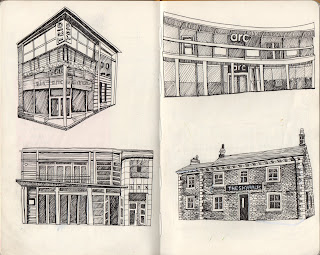What illustration means:
Drawing- a process of exploration, a tool used to record visually
Image making- Visual language, shape, form, colour, line, organising visual information
Illustration- Communication, problem solving, responding to a brief
We asked a lot of questions today:
- Who makes the rules to do with illustration?
- Do we have to stick to them, who says?
- Can other people (clients) define our practice and what we do?
- Can you be commercial and ethical at the same time?
- What happens if you can't get work?
- What happens if you get stuck in a rut?
Hopefully second year will provide the answers to some of these...
First Task
Define products, contexts and functions of illustration
Second Task
In groups we chose three categories from the following, and make the same lists of products,contexts and functions:
- Character and Narrative
- Editorial and Reportage
- Product and Packaging
- Object and Environment
- Publishing and Book design
- Retail and Merchandise
Third Task
Identify 5 examples of Illustration within the 3 categories:
Character and Narrative
Business-related character
Could be used to visually assist a publication such as a leaflet, or presentation to break it up a little and make it less black and white and more exciting.
Finn and Jake- Adventure Time
Created for a children's/young adult/ all ages animated television programme. Two fictional characters living in a post apocalyptical land having a different adventure each episode.
'Change for life' characters
This series of simplistic colourful figures were designed to help advertise and promote healthy lifestyles mainly to young people, but can apply to all ages in a society where obesity is a major crisis. They appear in leaflets, television commercials, billboards and more displaying and communicating ways in which to engage in activity, exercise as well as eating the right things.
M&M characters
The M&M characters are used to advertise the sugar coated sweets that have almost taken over the world... They appear on M&M packets, on TV advertising and more recently as merchandise in the M&M world stores. In the commercials the characters are usually contained in a 30 second short of day-to-day every life situations, interacting and joking with humans. If people like these characters and think that they are funny, this will increase interest, popularity and sale of M&M's.
Microsoft word assistant
A notorious character on the old windows 2000, designed to assist with any queries when using the programme. Occasionally popping up with little prompts, communicating directly with the user to make sure that they had the best possible experience with using it.
Editorial and Reportage
Editorial
Adam Quest - (untitled)
An editorial piece using an iPad as a visual metaphor for a blood transfusion; something which is essential to live. Is Facebook essential to live? It seems so in this day and age.
Andrea Wann - (image as part of a series about parenting teenagers)
Another editorial illustration communicating the changes and distant feeling when your children grow older and are no longer fully dependant on parental care, how that can make a parent feel.
John Holcroft - 'you are what you eat'
Illustration showing the fast food epidemic and how it is affecting the health of our society. How by eating unhealthy junk food can make you look and feel terrible.
Reportage (more about recording your surroundings)
Lizzy Stewart
Visual recording of food she ate in a particular day during a trip away; this informs the viewer about changes in culture and experience in general.
Veronica Lawlor
Another line and colour based sketch of times square in New York. It captures the busy feel and excitement of the hustle and bustle of the city.
Product and Packaging
Carolyn Gavin
Packaging for a Swedish brand of organic chocolate. Could this be aimed at women? The colour scheme and use of flowers are very stereotypically feminine; I couldn't imagine a man buying these.
Lacy Kuhn
Packaging for a new affluent yet fun cereal with the clever use of character and narrative combined in the imagery.
Mady Woodin
Colourful and intricate packaging for a range of Tesco's own brand soup.
Laura Gee
Illustrated phone case, a niche product for people who empathise with cats...
Sarah Thorne
Packaging for Topshop's makeup brand.


































